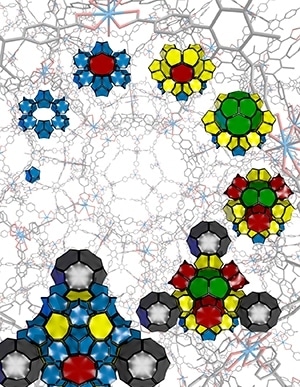May 24 2017
Researchers at Northwestern University have developed a structurally complex material from two basic building blocks that is the lowest-density metal-organic framework ever to be created.
 Self-assembly of a metal-organic framework (Credit: Northwestern University)
Self-assembly of a metal-organic framework (Credit: Northwestern University)
According to the design rules set by the Researchers, uranium atoms and organic linkers self-assemble into an attractive crystal — a large, airy 3D net of very roomy and beneficial pores. The pores are so roomy, in reality, that the Researchers have nestled a large enzyme within a pore which is no small achievement. The material can serve as a protective support for enzymes.
We are building with one-atom precision. Our material begins at the level of individual atoms, measured by angstroms, and ends on the hundreds of microns level, where we can hold the small crystal with a tweezers and see it with the naked eye.
Omar K. Farha, Research Professor of Chemistry, Weinberg College of Arts and Sciences
The research was published in the May 12th issue of the journal Science.
The material is extremely light, although it is made from uranium, one of the heaviest elements in the periodic table. They used uranium 238, a nonradioactive isotope for the research. The uranium atoms are spread out from each other in the structure that the metal-organic framework (MOF) takes the lowest density title from any of the competition.
“It is counterintuitive,” said Farha, who is an expert in the rational design of MOFs for catalysis, sensing and storage applications.
This material has not been seen or predicted before. Despite its simple beginnings, our MOF’s structure has an unparalleled structural complexity. And we’ve just scratched the surface of building sophisticated structures using simple building blocks.
Omar K. Farha, Research Professor of Chemistry, Weinberg College of Arts and Sciences
The discovery exposes the potential to develop basic design rules for self-assembly of open, intricate structures from simple building blocks while also underlining the potential of actinides, such as uranium, in materials production, Farha said.
Researchers presently can apply the new range of design rules for bottom-up construction to fabricate a variety of novel materials with pre-designed and predictable intricate structures.
Metal-organic frameworks are properly-arranged, lattice-like crystals. The nodes of the lattices are metals, and organic molecules link the nodes. The new MOF, called NU-1301, is composed of only uranium oxide nodes and tricarboxylate organic linker units. This simplicity makes the MOF industrially significant.
Besides the structural complexity, NU-1301 has a very high surface area, pore volume, and water stability and can be used to divide small organic molecules and large biological molecules, or enzymes, according to their charges and sizes.
Each unit cell — the standard unit that repeats in three dimensions to form the crystal structure — is made up of 816 uranium nodes and 816 organic linkers. One unit cell measures 173 angstroms across, and it continues repeating itself. The unit cells gather into pentagons and hexagons, ultimately growing into a crystal that can go up to a quarter of a millimeter in width.
The research paper is titled “Bottom-up construction of a superstructure in a porous uranium-organic crystal.” The research was supported by the U.S. Department of Energy, Office of Science, Basic Energy Sciences Program (grant DE-FG02-08ER155967).